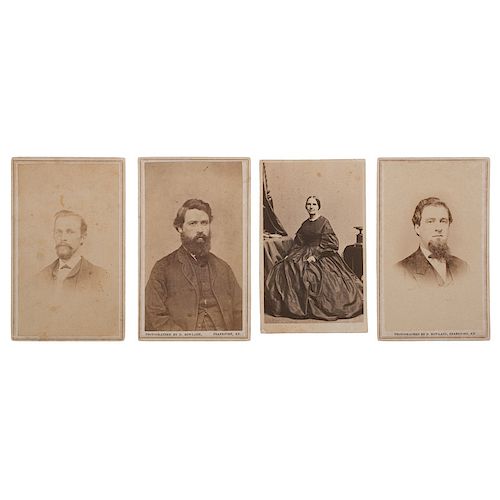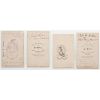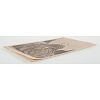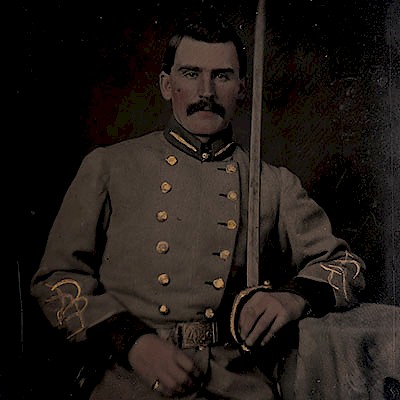Confederate CDV Collection, Featuring Possible CSA Spy Charlotte Moon Clark
About Seller
6270 Este Ave.
Cincinnati , OH 45232
United States
With offices in Cincinnati, Cleveland and Denver, Cowan’s holds over 40 auctions each year, with annual sales exceeding $16M. We reach buyers around the globe, and take pride in our reputation for integrity, customer service and great results. A full-service house, Cowan’s Auctions specializes in Am...Read more
Two ways to bid:
- Leave a max absentee bid and the platform will bid on your behalf up to your maximum bid during the live auction.
- Bid live during the auction and your bids will be submitted real-time to the auctioneer.
Bid Increments
| Price | Bid Increment |
|---|---|
| $0 | $25 |
| $500 | $50 |
| $1,000 | $100 |
| $2,000 | $250 |
| $5,000 | $500 |
| $10,000 | $1,000 |
| $20,000 | $2,500 |
| $50,000 | $5,000 |
| $100,000 | $10,000 |
About Auction
Jun 22, 2018
Cowan’s American History: Premier Auction, scheduled for June 22, 2018 is comprised of early photographs, documents, manuscripts, broadsides, flags, and more dating from the Revolutionary War, the Civil War, Late Indian Wars, World War I and II and beyond. Cowan's Auctions dawnie@cowans.com
- Lot Description
Lot of 4 CDVs, including possible portrait of Charlotte "Lottie" Moon Clark, with backmark of Bendann Bros., Baltimore. Clark (1829-1895) was a famous Confederate spy who, along with her sister, Virginia "Ginny" Bethel Moon, carried information and materials across Union lines to the Confederacy.
She was born in Albemarle County, VA, to a wealthy family who owned a cotton plantation along with several slaves. All three of Lottie's brothers served in the Confederate Army, perhaps inspiring her and Ginny to take up the cause of the Confederacy in their own way. After leaving 2nd Lieutenant Ambrose Burnside at the altar, Lottie married young attorney James Clark (who later became a judge) and settled in Jones Station, OH. Upon the start of the Civil War in 1861, Lottie turned her attention to assisting the South, despite the great personal risk. There are numerous anecdotal incidents reported about Lottie's life and experiences as a spy, including the following on about a carriage ride with President Abraham Lincoln himself.
Lottie attended a meeting in Toronto, Canada in 1862 at which espionage agents gathered to collect information. After the meeting, she allegedly traveled to Washington, D. C. and pretended to be an English noblewoman with a health condition requiring her to try bathing in the warm, healing waters of Virginia. She spoke with Secretary of War Edwin Stanton, requesting permission to continue on her journey, and he obliged. The next day, both Stanton and President Lincoln traveled to Richmond, allowing Lottie a seat in their private carriage. As they traveled, Lottie acted as though she had fallen asleep and listened intently as the two men exchanged confidential information about the war. When they arrived in Virginia, Lottie took this information straight to Jefferson Davis himself. This information allowed the Confederate Army to anticipate and defend against Union Army movements for months.
Once Stanton and Lincoln figured out that they had been tricked, the Secretary of War set a price of $10,000 on Lottie's head, dead or alive. Though she continued her exploits against the Union for a while longer, she was caught trying to cross from Cincinnati over to Kentucky when her ex-fiance, General Burnside, recognized her and she gave up her disguise. Lottie was put under house arrest at the Burnet House in Cincinnati on the condition that she promise not to spy for the Confederacy anymore during the war. After the war, Lottie and her husband moved to New York where she became a journalist, notably reporting on the Franco-Prussian War from various locales in Europe. After Lottie's death, a collection of letters from Confederate prisoners held at Camp Chase were discovered in the State House at Columbus, Ohio. Evidence suggests that these were letters were intended to be given to Lottie, so that she could deliver them to Richmond. The letters were not delivered, but they provide a fascinating glimpse into one of Lottie's many attempted missions for the Confederacy.
CDV bust portrait of Private William D. Isbell, of the Lynchburg Light Artillery, in civilian clothing. Credited on verso to Tanner & Van Ness, Lynchburg. William D. Isbell (1839-1912) enlisted as a private on May 10, 1861, and was mustered into the Virginia Lynchburg Light Artillery that same day. He was wounded at Malvern Hill on July 1, 1862, and recovered at Chimborazo Hospital in Richmond, Virginia.
CDV bust portrait of CSA Captain William Johnson Stone, of the 2nd Kentucky Regiment, in civilian clothing. Credited on mount to D. Rowland, Frankfort, with Mrs. James O'Donoghue's Frankfort Art Gallery imprint on verso. Ink inscription on verso reads, "Capt. W. J. Stone to Miss Mary Gardner." William Johnson Stone was listed as a POW twice, first at Fort Donelson, TN, and second at Cynthiana, KY. He was also wounded in Cynthiana, resulting in a right leg amputation. Surviving the war, Stone went on to serve Kentucky in the state House of Representatives and represented Kentucky at the 49th-53rd United States Congresses.
CDV portrait of Joseph Gardner (possibly the brother of Mary Gardner), in black suit. Credited on mount to D. Rowland, Frankfort, with Mrs. James O'Donoghue's Frankfort Art Gallery imprint on verso. Ink inscription on verso reads, "Joseph Gardner, Born 1st. Oct 1835." Joseph Gardner (1835-1887) served Kentucky counties Morgan, Breathitt, and Magoffin in the state senate during the Civil War. Gardner was also a candidate for lieutenant governor, but died before the election.
Source: Kaufmann, Patricia A. "Confederate mail runner and Spy Lottie Moon Clark and a New Look at the Undelivered Camp Chase Letters." The Confederate Philatelist, Fourth Quarter 2016, 4-18.
Possible Charlotte Moon Clark CDV with spotting and tearing/wear (including partial separation of photograph from mount at lower right and tear with paper loss at upper right) at edges. Isbell CDV with soiling/discoloration throughout, including several small dark spots at Isbell's right shoulder. Stone CDV with some spotting and discoloration throughout. Gardner CDV with soiling including some small markings over Stone's jacket and vest.Condition
Eliminate the Hassle of Third-Party Shippers: Let Cowan's Ship Directly To You!
If you'd like a shipping estimate before the auction, contact Cowan's in-house shipping department at shipping@cowans.com or 513.871.1670 x219. - Shipping Info
-
Buyers are required to pay for all packing, shipping and insurance charges. Overseas duty charges are the responsibility of the successful Bidder. Be aware that for larger and/or valuable items, shipping charges can be substantial. - If there is no shipping amount on listed your invoice, you will need to make arrangements to pick up or ship your purchase through an alternative shipping company. Our shipping department can be contacted at 513.871.1670 (ext. 219) or email shipping@cowans.com. - Shipping charges include insurance for your order while in transit. If you have private insurance we will adjust your charge to include only packing and shipping. - Please allow 14 – 21 days after payment to package and ship your purchase as carefully as possible.
-
- Buyer's Premium



 EUR
EUR CAD
CAD AUD
AUD GBP
GBP MXN
MXN HKD
HKD CNY
CNY MYR
MYR SEK
SEK SGD
SGD CHF
CHF THB
THB













